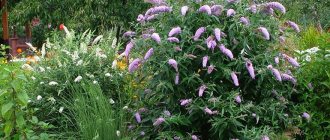Autumn has arrived with a unique variegation of colors, a trail of bright yellow and crimson leaves drags along the ground, it would seem that the long-awaited rest for gardeners and gardeners has arrived. But many years of experience of gardeners suggests that this is not the time to relax - you need to have time to prepare the seeds and soil for winter sowing. From early spring, the flowerbeds of experienced gardeners who know what flowers to sow before winter are full of bright shades of all kinds of flowers, because winter sowing presupposes earlier germination.
Values of sowing seeds before winter
Many gardeners prefer winter sowing, because this method has a high chance of growing strong, hardy crops. Painstaking work in the fall is justified in the spring, when cornflowers, chrysanthemums, marigolds, carnations, bells and many other garden inhabitants appear, decorating the flower beds.
Advantages of sowing seeds before winter:
- Seeds germinate in a familiar, natural habitat; reproduction occurs autonomously from human efforts.
- Grown plants are endowed with endurance, they are not afraid of frost and are less susceptible to diseases. Healthy and deep roots are endowed with the ability to feed on moisture deep underground, so dry weather and weeds are not a problem for such flowers.
- Earlier flowering.
- In spring, you don’t have to worry about the seedlings; additional space on the windowsills is freed up for non-frost-resistant crops.
- Flowers that are sown before winter germinate without human intervention; you don’t have to worry about sufficient warming of the earth.
- Natural selection - stronger seeds germinate, and flowers grow stronger and healthier.
- With the help of natural selection, growing flowers in this way from year to year, you can achieve an improved variety of your own.
- Lack of pests in the initial stages of growth.
People usually read along with this article:
How to plant tulips before winter: proper planting of tulips in winter. Planting tulips in the fall before winter is much more profitable and reliable. In addition to the fact that the first shoots appear immediately at the beginning of spring, during the winter the bulbs undergo a kind of preparation by cold. Thanks to this “preparation,” germination increases and the plant develops better.
Marigolds: growing from seeds, when to plant seedlings and how to care for them. How to sow marigolds? Is it worth it to “suffer” with seedlings or plant the seeds directly in the ground? What are the advantages and disadvantages of these methods? Are there any special features for caring for seedlings? You will get answers to these and other questions from “Gardener and Ogorodnik”.
Perennial marigolds: planting and care, proper cultivation in a flowerbed. It would seem that marigolds are very unpretentious flowers. We can see them in most city flower beds. However, it is still not worth abandoning plants completely to the mercy of fate. A flowerbed with them also requires care if you want to grow strong, handsome plants that will last until frost.
Varieties of marigolds: low-growing, thin-leaved, rejected, erect, etc. Choosing varieties of marigolds for a flower bed is not an easy task. There are quite a few varieties and species of these flowers, and each has its own unique difference. To make your choice easier, Gardener and Gardener offers to familiarize yourself with the features of the marigold variety series.
Soil fertility is not always related to its type. Any land that is used for a long time needs feeding. Plants simply deplete the fertile layer. It becomes more dense and it becomes difficult for the roots to break through the fossilized layers. Nutrient additives are used to improve soil quality.
When to sow seeds in open ground
Sowing seeds before winter should be done only with the onset of stable frosts. If you hurry and plant earlier, the seeds may germinate and die in frost. The optimal time for planting is at the end of October. In some regions with warm climates, a thaw is likely even in late autumn, and it is better to postpone sowing until mid-November. It is necessary that the open ground freezes to 4 degrees, and the air temperature during the day drops below 0 degrees.
Video “When to sow seeds before winter”
Rules for autumn sowing of seeds
The soil is prepared in September as follows:
- It is dug up using a shovel and the clods of earth are carefully broken up.
- The beds are well watered.
- The beds are completely cleared of weeds.
- The required fertilizing is added; you can use compost, peat, humus or ready-made mineral fertilizer complexes.
- Neat furrows are formed for future crops.
In November - early December (depending on the weather), seeds are planted in the formed furrows: smaller ones - to a depth of 1.5 cm, large ones - 4-6 cm.
Freezing of the upper layers of the soil can be considered a signal to start planting.
Sow the seeds as thick as possible, covering the top with a mixture of compost or humus and sand. After the emergence of seedlings in the spring, they must be thinned out for normal growth and development of plants.
How to sow seeds before winter
Pre-winter sowing of seeds can be carried out in a shkolka - a special bed where all comfortable conditions for the development of plants have been created. Sowing in containers is also widespread to prevent the plant from being washed away by melt water.
Sowing seeds for school
The bed should be located on a southern elevated space. The optimal height of the bed is 20 cm. With such a bed size, the possibility of plants being washed away by melt water is eliminated, and the soil warms up faster. The soil begins to be prepared long before sowing, from mid-September. The soil is deeply loosened, complex fertilizers enriched with minerals, potassium, and phosphorus are applied. Coarse river sand with humus is added to clay soils, then the ground is leveled, compacted and furrows are made. The holes should vary in depth according to the size of the seeds. Small seeds are sown to a depth of 1 cm, medium ones - 2 cm, large ones - 4 cm. The school is covered with film, since snow may fall before sowing the seeds. The seeds need to be dried before sowing.
At the end of October - beginning of November you can start sowing. To do this, remove the film and place several seeds in the holes. Large seeds are placed in smaller quantities in each hole, small ones in larger quantities. You need to prepare the soil mixture in advance. To do this, you need to mix humus, peat and sand. The holes are filled with prepared substrate. Collect fallen leaves and dried grass and cover the ground for insulation. No need to water.
In the spring, when the snow melts, the mulch is removed and wait for germination. When two true leaves appear, the plant needs to be thinned out as much as possible. After half a month, when the flowers have grown stronger, you need to remove the interfering shoots again. When weeding, it is recommended to carefully loosen the soil near the flowers, without touching the roots.
Sowing seeds in containers
Before starting work in the garden, stock up on suitable pots, prepare a soil mixture, coarse and fine sand, markings with the names of flowers, and drainage.
Suitable containers for sowing before winter:
- The pots should be small 7-10 cm.
- Be sure to have drainage holes.
- The container for sowing should not bend easily, so as not to damage the root system of the flowers; it is better to choose plastic or wooden cups with dense walls.
For winter sowing, it is recommended to use a special substrate. It should be loose enough for the germination of small roots and not allow moisture and air to pass through. To obtain a soil mixture, mix three parts of peat and sand and one part of soil. Before planting, you need to slightly moisten the substrate.
Expanded clay, small stones, small pieces of bricks are suitable for drainage. To avoid getting entangled in plants, use markings. They indicate the name of the crop and the date of sowing.
Technology for sowing seeds in containers:
- 2 cm of drainage is poured into the bottom of the container.
- Then you need to pour the soil mixture. There should be a distance of 2 cm between the substrate and the top of the pot.
- Lightly compact the substrate.
- They lay the seeds. Small seeds can be mixed with sand.
- Water the containers with the contents.
Popular types
Foreign nasturtium (Tropaeolum peregrinum)
|
Large nasturtium (Tropaeolum majus)
|
Tuberous nasturtium (Tropaeolum tuberosum)
|
Nasturtium Day and night
|
Shield nasturtium (Tropaeolum peltophorum)
|
Nasturtium (Tropaeolum beuthii)
|
We suggest you familiarize yourself with How to plant a cedar seedling
What flowers to sow before winter
You can sow both perennial and annual flowers before winter.
Perennial flowers that can overwinter in open ground:
- delphinium,
- bell,
- yarrow,
- carnation,
- doronicum,
- gaillardia,
- gentian,
- primrose,
- lavender,
- aquilegia,
- aconite,
- alpine aster,
- arabis alpine,
- aster novobelgica,
- buzulnik,
- spurge,
- Heuchera,
- gypsophila.
- clarkia marigold,
- linen,
- lupine,
- poppy,
- nasturtium,
- mignonette,
- hop,
- eschscholzia Californian,
- cornflower,
- nigella,
- calendula,
- Lavatera,
- lobularia marine,
- agrostemma vulgaris.
- asters
Even an inexperienced gardener can grow all these flowers, following the rules for planting seeds before winter. The main thing is not to sow seeds ahead of time, prepare the soil in advance, and apply the necessary fertilizers. On summer evenings it will be so pleasant to admire the garden full of fragrant flowers grown with your own hands.
Golden autumn is behind us, the garden is ready for winter, and the flower garden is clean and tidy. If you are not used to sitting idly by, you want to relieve the pressure on the spring sowing, and at the same time the window sills, and get strong, well-formed plants, then it’s time to prepare for the winter sowing of annuals.
- Sowing before winter: what is it?
- When is it sown before winter?
- Advantages of winter sowing of annuals
- Disadvantages of winter sowing of annuals
- Options for sowing annuals before winter
- Technology for sowing annuals before winter in a flower garden or shrub
- Technology for winter sowing of annuals in containers
- What annuals are sown before winter?
- Annuals with a tap root system
- Other annuals
- Annuals for winter sowing in the southern regions
- Self-seeding
Features of nasturtium
Nasturtium is considered one of the most unpretentious inhabitants of domestic flower beds. Photo: plants-1.ru
- Origin . Nasturtium (lat. Tropaéolum) – also called capuchin. A herbaceous plant belonging to the Nasturtium family. This plant is native to South America.
- Types and varieties . More than 90 varieties of the flower have been recorded. There are 2 large directions in the family - perennial and annual nasturtium; there are also climbing and bush varieties.
- Appearance . The leaves are light green, shield-bearing, entire, sometimes dissected, with a long petiole. Flowers can be double and single-level, usually five-petaled, axillary, bisexual; in Russia, flowering begins in mid-June and continues until cold weather.
- Usage . The foliage, flowers and fruits of the plant have medicinal properties. The fruits and young shoots are used in cooking. Planting nasturtium to enrich poor soils is very popular; this species normalizes the soil in a few years, plus plants next to it are not threatened by diseases and pests.
- Reproduction . Capuchin reproduces exclusively by seeds. Sometimes growing seedlings from seeds is used; this technique is caused by the desire of gardeners to speed up the flowering time.
Capuchin can be cultivated as a container, flowerbed and climbing plant.
Photo: i0.u-mama.ru The video shows growing nasturtium from seeds in seedlings with subsequent planting in the ground. The florist dwells in detail on when to plant, how to plant and how to feed the flower.
When is it sown before winter?
There is no need to rush - warm weather can stimulate the emergence of seedlings that will die when frost sets in.
When sown in winter, annuals bloom 2-3 weeks later than those grown through seedlings, but a week earlier than those sown in the ground in the spring.
planting before winter
Autumn planting of bulbous and rhizomatous plants
Many bulbous plants are not adapted to wintering in the ground. Sub-zero temperatures are detrimental to underground shoots of dahlia, whitewing, and canna. But hazel grouse, hyacinths, viper onions, crocuses, daffodils, and tulips are not afraid of the cold.
When and how to plant lilies in the fall
When to plant lilies in the fall depends on the local climate. In Siberia, the deadline will be the end of August, in the Moscow region - October. In the southern regions, the procedure can be carried out until the end of November. You should focus on the air temperature, it should drop to +10°C and no longer exceed this mark.
Planting lilies in the fall is preceded by site preparation, taking into account the fact that the plants will live in one area for three to five years. It is recommended to dig up the soil, add humus, superphosphate and potassium sulfate.
Having decided when it is most favorable to plant lilies in the fall in your area, dig holes. The depth of each hole is three times the height of the bulb. Place a layer of sand on the bottom and straighten the roots. Fill it with sand first, then soil. Water and mulch the plantings: oriental species with peat/sawdust, snow-white lily and hybrids with a mixture of humus and wood ash. At this point, the program for planting lilies in the fall can be considered completed. Covering with spruce branches will be required only if a sharp drop in air temperatures occurs before snow falls.
Transplanting lilies in the fall also gives good results. It is carried out once every five years, usually a month after the end of flowering. The stem is cut as close to the surface of the earth as possible, the bulb is carefully dug out, trying not to damage the roots. Remove dead scales and separate the babies. It is advisable to soak the bulbs in a solution of karbofos for 30–40 minutes. Further transplantation of lilies in the fall completely coincides with the initial planting of plants.
When to plant tulips in autumn
Gardeners often wonder at what period of the autumn period to plant tulips in order to enjoy the beauty of flowering from the first days of spring.
Just like with lilies, you should focus not on the calendar, but on the climate and weather. Early planting leads to the appearance of sprouts that are not able to survive the first winter frosts. Later turns into belated flowering. Therefore, to choose the time, you need to monitor the soil temperature. As soon as it reaches +5–7°C, you can plant the bulbs in the flowerbed.
In the middle zone, the optimal time is from September 15 to October 5. In warm autumn, you can shift the dates by 5-10 days. When the soil temperature is higher, the bulbs take root more slowly and are more often affected by diseases. If the soil is dry during planting, watering is necessary.
Autumn is the time to transplant and divide peonies
Herbaceous peonies can live in one place for a long time. However, it is recommended to rejuvenate five-year-old plants: divide and replant. This procedure has a beneficial effect, stimulates active growth and abundant flowering. Tree peonies are more susceptible to stress from replanting; until the bush reaches 10 years of age, it is better not to disturb it.
The best time to replant both herbaceous and tree-like peonies is considered to be the end of August–beginning of autumn. By this time, the plants have already faded and have time to grow new roots, which will greatly facilitate rooting in a new place. However, when choosing a transplant date, you should also focus on your climate zone:
- from August 20 to September 20 - transfer time for the Urals/Siberia;
- from August 25 to September 25 - for the Middle Zone/Moscow region;
- September 1–30 — for the South of Russia.
The rhizome is carefully dug up and divided into parts, leaving each with at least three buds and three adventitious roots. The sections are processed and dried.
Forming the perfect flower garden for summer
When selecting plants for planting in the fall, adhere to the basic rule for forming a flower garden: the center of the flowerbed should be occupied by tall plants with wide leaves; short, beautifully flowering species should be allocated zones along the edges.
To make your flower garden happy with bright colors all summer long, make a flowering calendar for your plants. Select varieties and species whose flowering follows one after another.
Advantages of winter sowing of annuals
- Pre-winter sowing creates natural growth conditions. Essentially, the seeds undergo vernalization, resulting in stable, strong seedlings.
- Spring weather is changeable, with warmth followed by cold weather. It can be difficult to choose when to sow. The seeds sown before winter will themselves determine the optimal conditions for the start of growth.
- Pre-winter sowing is a wonderful alternative to spring sowing in places where the soil remains cold for a long time in the spring. Weather conditions unfavorable for spring sowing - late spring, low amount of moisture - do not affect seeds sown before winter, which use moisture from melting snow.
- Pre-winter sowing eliminates labor costs for preparing seeds for spring sowing and saves space on window sills. Stratification (needed, for example, by Adonis seeds) in case of sowing before winter will be carried out by nature instead of you.
- The seeds undergo natural selection - the strongest survive. They produce strong seedlings characterized by good growth and resistance to adverse weather conditions, spring frosts, and diseases.
- After winter crops emerge, the plants are thinned out. The remaining ones, due to the fact that they were not touched, form not a fibrous (as in picking), but a core, deeper-lying root system. This makes them more drought-resistant.
Benefits for plants
The marigolds left over from thinning can be planted throughout the entire area; they will be in place everywhere, because they are a kind of orderlies for the garden.
- planted next to potatoes and tomatoes to get rid of fungal diseases;
- planted along the perimeter of beds with onions and carrots - repels onion and carrot flies;
- can be planted among garden strawberries, since marigold roots contain substances that attract nematodes, which die among these roots;
- asters often suffer from “black leg”, tagetes save them from this disease;
- the smell of flowering plants and tops repels aphids, spraying with infusion is especially helpful (let it sit for two days, ratio 1:1 tbsp soap);
- If you put plants in compost in the fall, this will help disinfect it from fungi.
Disadvantages of winter sowing of annuals
- Before winter, it is advisable to sow only seeds of cold-resistant plants that can safely withstand spring frosts.
- Thaws and subsequent frosts can contribute to premature awakening of seeds and death of sprouts.
- Prolonged waterlogging has an extremely negative effect on winter crops. It is very important to choose the right site for sowing and prepare it well.
- The germination rate of seeds is lower, since seedlings immediately find themselves in unfavorable conditions and the fittest survive. Therefore, we have to sow more. When sowing in winter, it is recommended to increase the seeding rate by 30% compared to spring.
How to care for nasturtiums after flowering
After the nasturtium flowering period has passed, there is no need to stop watering it, but gradually soil moisture is reduced to a minimum. Since it is the annual nasturtium species that are usually grown, here is what you will need to do as autumn approaches:
- remove nasturtium bushes from the beds;
- dispose of plant remains in a compost heap or burn.
The cleared soil needs to be dug up, removing weed roots and other debris. If desired, fertilize the area before winter by adding organic matter to the soil, but not a bucket per square meter, as is customary, but three times less, since, as we have already said, an excessive amount of organic matter will lead to the growth of green plants and the absence of flowers .
After flowering, nasturtium must be removed from the flowerbed.
Options for sowing annuals before winter
- Pre-winter sowing of annuals in a permanent place in the flower garden is optimal for plants with a tap root system that react painfully to transplantation (poppy, delphinium, eschscholzia) . Disadvantage - the possibility of selecting the optimal location for placing crops is excluded.
- Pre-winter sowing of annuals in shkolka is carried out with the aim of further transplanting the seedlings into the flower garden. In the spring, when shoots appear above the school, you can install a frame and cover it with lutrasil, simulating a greenhouse. In this way, you can get high-quality seedlings early.
- Winter sowing of annuals in containers is optimal when the soil conditions of the site or close groundwater make winter sowing difficult.
Note to the gardener
Why do nasturtium leaves turn yellow?
Yellowing of leaves is a natural process that comes with aging. In any case, yellow leaves must be removed.
However, there are several reasons when this is not normal:
- Leaf burn. To avoid this, shade the plant during particularly hot hours.
- You watered it too much, which caused the soil to become waterlogged. Reduce watering and water only when the soil is dry.
- You planted a plant in the shade and it doesn’t get enough sun. You can try replanting nasturtium.
- The plant is sick, for example with mosaic.
- The soil is poor in micro and macro elements. Introduce light mineral supplements.
Why don't nasturtiums bloom?
There may be several reasons:
- You “overfed” it with nitrogen-containing fertilizers and all the nutrients went into the growth of the vegetative mass;
- You planted it too thickly and the plants have to spend energy on competition rather than flowering;
- If you are growing it at home, then it simply may not have enough light or space in the pot;
- Improper care - too shady place or too much watering.
Technology for sowing annuals before winter in a flower garden or shrub
The school for winter sowing of annuals should be placed on an elevated area, oriented to the south or southwest. It is advisable that it is not exposed to cold winds and is covered with snow in winter. If the groundwater is close, the shrub should be made at least 20 cm high. This will help avoid the seedlings getting wet in the spring and contribute to faster warming of the soil.
A ridge or section of a flower garden for winter sowing is prepared in the second half of September - early October. They dig deep, apply complex mineral fertilizer with a predominant content of potassium and phosphorus, as well as humus. Heavy soils are improved by adding coarse river sand. After leveling and compacting the soil, rows or nests are outlined (according to the plant placement scheme, if the flower garden is created by sowing seeds in the ground).
For small seeds, the optimal sowing depth is 0.5-1 cm, for medium ones - about 2 cm, for large ones - about 4 cm. The bed prepared in this way can be covered with film. If snow falls, this will help you quickly start sowing.
Growing snapdragons from seeds
Sowing
This plant can be propagated by seeds or by vegetative means. The seeds have good germination for several years. If you live in an area with a relatively mild climate, then sowing the seeds of such a flower can be done directly into open soil. The first shoots can be seen after 2.5–3 weeks, while the seedlings are not afraid of cold snaps that occur at night. In places where spring is relatively cold, this plant is recommended to be grown through seedlings. Growing snapdragons from seeds is very easy.
Seeds are sown in the first days of March. To do this, you will need a bowl with a diameter of at least 10 centimeters, and it should have holes at the bottom for drainage. Coarse sand should be poured onto the bottom, and compost soil mixed with sand should be placed on top of it. Lightly compact and level the surface, then moisten it a little with a spray bottle and distribute snapdragon seeds mixed with sand, pour a thin layer of the same substrate on top. Water the crops using a fine spray bottle, and then cover the container with clear glass. Every day, condensation must be removed from the surface of the glass, while ventilating the seedlings and, if necessary, moistening the surface of the substrate with a sprayer. If the place where the container is located has moderate humidity and warmth (23 degrees), then the first seedlings can be seen after half a month. After the first plants appear, the container must be moved to a well-lit place, but at the same time protected from direct rays of the sun (so that the plants do not stretch out). After the snapdragon begins to emerge en masse (after 3–4 days), the shelter must be removed for good.
Seedling
At first, the plants will grow for quite a long time, and during this period it is especially important to properly moisten the soil. Watering should be done in the morning so that the plants have enough moisture, but not too much of it
The fact is that waterlogging can cause the development of “black leg”. If the seedling has fallen, it should be carefully removed using tweezers, and the place where it grew should be sprinkled with crushed charcoal or calcined cold river sand should be used for this. After 2 true leaves are formed, the seedlings must be picked into a box or container, and they must be placed so that they are not pressed against each other. You can also use individual pots for picking plants, or you can plant 3 seedlings at once in 1 larger pot. Then the plants should be placed in a well-lit place, but at the same time protected from direct sunlight. After this, you can begin hardening the seedlings. To do this, during the daytime you need to open the window for a while, but you should avoid drafts. When the plant has 4-5 true leaves, it will need to be pinched to increase bushiness, but if the side shoots grow quite quickly, then they should also be pinched.
Technology for winter sowing of annuals in containers
- Containers should be shallow (7-10 cm) and have drainage holes.
- The substrate should be loose, moisture- and breathable and moderately nutritious. The optimal soil mixture consists of garden soil, peat and coarse river sand or vermiculite (1:3:3).
- A 2 cm layer of drainage is poured onto the bottom of the container. A layer of soil mixture 4-6 cm thick is compacted, and the dry soil is slightly moistened. The remainder of the substrate is left in a frost-free room for backfilling the sown seeds.
- The prepared containers are placed in the garden in trenches or holes 15-20 cm deeper than the height of the container. This difference is filled with drainage poured onto the bottom, and the gaps between the placed containers and the edges of the trench or hole are filled with leaf litter.
- The top of the container is covered with film.
- As soon as the sowing time has come, the film is removed from the containers, the seeds are distributed evenly over the surface of the soil and covered with the remaining soil mixture. The thickness of the layer depends on the size of the seed (see above).
- The top of the crops is mulched with leaf litter, which is removed after the spring snow melts. In spring, crops are thinned out twice: at the stage of the first pair of true leaves, then two weeks later, maintaining the distance between seedlings for a particular plant type.
- At the end of May - beginning of June, plants are planted in the flower garden.
preparing the site for winter sowing
Preparing soil and seed
The beds for sowing flowers are prepared in late August - early September. Choose a sunny, wind-protected place where snow retention will be ensured. Areas on the south side of the house are suitable.
How to plant cucumbers in open ground with seeds
Humus or well-rotted manure 4-6 kg/m², superphosphate 30-40 g/m², potassium chloride 30 g/m² are added to the bed, dug up to the depth of a spade bayonet and well leveled with a rake. Then make grooves 4-5 cm deep at a distance of 12-15 cm.
Attention! Seeds should not be soaked or germinated before winter sowing.
The soil that will cover the furrows after sowing is removed indoors before the onset of frost. For example, you can collect a bucket of garden soil or buy a 5-liter package of fertile soil.
What annuals are sown before winter?
- Firstly, they are cold-resistant.
- Secondly, with a short growing season - about 40-60 days from germination to flowering.
- Thirdly, they are able to be content with the small amount of warmth that our northern summer gives.
Pre-winter sowing is a wonderful opportunity to have strong, healthy seedlings of annuals whose seeds do not last long (for example, delphinium ), and whose seedlings do not tolerate transplantation due to their tap root system.
Growing and care
Despite their delicate appearance, nasturtiums are impressively resilient plants with minimal requirements. Nasturtiums are successfully planted and cared for on the balcony and in the garden. Plants are able to survive periods of drought and high temperatures. Unlike many other annuals, they do not require additional fertilizer even when grown in pots or containers.
Watering
The correct position is the basis for growing a flower. Once the seeds hit the ground, there will be little work to do on the plant. Success in growing nasturtium is largely due to proper watering. The frequency and amount of water should be appropriate to the plant size and position. On a sunny balcony, nasturtiums will need more water than in a shady garden. The appearance of the first flower is a signal to increase watering.
Annuals with a taproot system for winter sowing
- Delphinium Ajax: medium seed size, planting pattern 30 x 20 cm.
- Clarkia marigold: small seed size, planting pattern 20 x 25 cm.
- Large-flowered flax, sowing flax: large seed size, planting pattern 15 x 20 cm.
- Hybrid lupine: large seed size, planting pattern 20 x 30 cm.
- Self-sowing poppy: small seed size, planting pattern 20 x 30 cm.
- Mattiola gray: medium seed size, planting pattern 20 x 25 cm, 25 x 25 cm.
- Large nasturtium, cultivated nasturtium: large seed size, planting pattern 20 x 30 cm.
- Fragrant mignonette: medium seed size, planting pattern 15 x 25 cm.
- Climbing hop, or Japanese: seed size is small, planting pattern 25 x 30 cm.
- Californian Eschscholzia: medium seed size, planting pattern 20 x 25 cm, 25 x 25 cm.
Nasturtium blooms beautifully when sown in winter and can be propagated by self-sowing
Other annuals that are often sown before winter
- Agrostemma vulgaris: the seed size is small, the planting pattern is 15 x 20 cm, sowing is carried out in nests of 3-4 seeds.
- Adonis summer, annual Adonis, or autumn: seed size is large, planting pattern 25 x 15 cm, 30 x 20 cm, seeds are photosensitive, recommended planting depth 1-1.5 cm.
- Marine alyssum (marine lobularia): the seed size is small, the planting pattern is 15 x 20 cm. With thickened crops, there is a high probability of being affected by powdery mildew; timely thinning of the seedlings is necessary.
- Blue cornflower: large seed size, planting pattern 15 x 20 cm.
- Gaillardia is beautiful: the seed size is medium, the planting pattern is 25 x 30 cm, it allows mass self-seeding.
- Gypsophila graceful: medium seed size, planting pattern 15 x 20 cm.
- Iberis umbellata: medium seed size, planting pattern 25 x 15 cm. Winter crops are susceptible to cruciferous flea beetle attack. For prevention, the soil is dug up in the fall and cultivated in the spring.
- Calendula officinalis: seed size is large. The planting pattern depends on the type and variety: 30 x 30 cm, 40 x 40 cm, 30 x 10 cm.
- Calistephus chinensis (annual aster): medium seed size, planting pattern 20 x 35 cm. When sown in winter, plants are less susceptible to fusarium.
- Three-month-old Lavatera: large seed size, planting pattern 25 x 30 cm.
- Nigella sativa: medium seed size, planting pattern 15 x 20 cm.
calenula reproduces by winter sowing, produces self-sowing
Diseases and pests
| Rust Symptoms: First, a red, dusty coating appears on the foliage, and then on the stems. Gradually, the fungus grows and can destroy the plant completely. What to process: Bordeaux mixture helps as a preventive and therapeutic agent; for prevention, the soil is treated in a concentration of 1%, for treatment the concentration is 3%. | |
| Mosaic Symptoms: The leaves become covered with light green spots, which later grow and turn yellow. What to process: Baktofit, Topaz and Fitosporin help | |
| Cruciferous flea beetles Symptoms: Small bugs, dark with a golden tint. They eat away the leaves and destroy the buds before they bloom. What to process: Treat the plant with Decis or Aktara |
It is also possible to sow before winter:
- Chinese carnation, hybrid carnation: medium seed size, planting pattern 20 x 25 cm.
- Double-pinnate cosmos, sulfur-yellow cosmos: large seed size, planting pattern 30-35 cm between nests, 3-4 seeds per nest. The seeds are photosensitive, the recommended planting depth is 1-1.5 cm. In unfavorable weather, flowering may occur late and be interrupted by early autumn frosts.
- Pyrethrum maiden (matricaria exceptional, chrysanthemum maiden): seed size is small, planting pattern 20 x 25 cm.
- Scabiosa dark purple: large seed size, planting pattern 25 x 30 cm.
- Maned barley: medium seed size, planting pattern 20 x 30 cm.
Main types and varieties
Today, experts have several classifications of this plant according to various characteristics. The most popular classification is based on the height of the bush. Based on the size of the bush, snapdragon varieties are divided into 5 groups:
- Gigantic - bush height 90–130 centimeters. This plant has a centrally located stem that is much higher than the second-order stems, while there are no third-order stems. Popular varieties: “Arthur” - bush height from 90 to 95 centimeters, cherry-colored flowers; “F1 red XL” and “F1 pink XL” - the bush reaches 1.1 meters, the flowers are red and pink (respectively).
- Tall - bush height 60–90 centimeters. They are cultivated for cutting, as well as as a vertical accent in groups or in mixborders. The central stem is much higher than the lateral ones. When cut, the flowers of this plant can last for about 7 days or even longer. The most fragrant varieties are those whose flowers are painted in various shades of yellow. Popular varieties: “Anna German” - the flowers are light pink; "Canary" - deep yellow flowers; a mixture of Madama Butterfly varieties - double flowers can be painted in a variety of color shades.
- Medium-sized (semi-tall) - a bush with a height of 40 to 60 centimeters. The varieties are universal; they are cultivated both for cutting and as a decoration for flower beds. They are distinguished by their strong branching. The central stem is not much higher in height than the lateral ones. Popular varieties: “Golden Monarch” - has a yellow color; "Ruby" - deep pink flowers; “Lipstick silver” - painted whitish-pink.
- Low - bush height 25–40 centimeters. They are cultivated as border or flower bed plants. These varieties have a large number of flowering stems of the second and third order, while the central stem has the same height as the stems of the first order or is slightly lower than them. Popular varieties: “Tip-top”, “Hobbit”, hanging hybrid plant “Lampion”.
- Dwarf - the height of the bush varies from 15 to 20 centimeters. The varieties are intended for carpet flower beds, ridges, borders, rock gardens. They are also grown as a potted flower. There is strong branching up to the third and fourth order stems, while the central stem is lower or has the same height as the second order stems. Popular varieties: “Sakura Color” - there is a spot on the whitish-pink flowers; "Candy Showers" is a hanging variety.
There is also the very popular Sanderson and Martin snapdragon classification for year-round cut varieties. However, this classification is of interest only to those gardeners who grow snapdragons for sale.
In the southern regions of Russia, winter sowing of the following annuals is effective:
- Antirrinum large (snapdragon): small seed size, planting pattern 20 x 30 cm.
- Bidens ferulefolia: seed size is medium. Planting pattern: 30-35 cm between nests, 3-4 seeds per nest.
- Godetia grandiflora: small seed size, planting pattern 15 x 20 cm. Painless transplantation is possible only at a young age.
- Sander tobacco: small seed size, planting pattern 20 x 30 cm.
- Chrysanthemum keeled, Chrysanthemum sativa: seed size is large. The nests are arranged according to a pattern of 25 x 25 cm or 30 x 30 cm, with 3-4 seeds per nest.
- Swamp chrysanthemum: medium seed size. The nests are arranged according to the pattern 20 x 20 cm or 25 x 25 cm, 3-4 seeds per nest.
Self-seeding of annuals
Many annual flower crops, under favorable conditions, give more or less abundant self-seeding, but not all of them are recommended for winter sowing, since they have a long growing season (snapdragon) or require a lot of heat (petunia, lobelia) , as a result of which they are observed during winter sowing. late flowering, or even the plants do not have time to bloom at all. It should be borne in mind that in the offspring obtained as a result of self-seeding, splitting of characters is often observed.
Planting annual and perennial flowers before winter has its advantages in many ways. The seeds undergo good hardening, and in the spring they produce high-quality seedlings that are characterized by good growth and are resistant to frost and disease.
Time is fleeting, it was just spring, and suddenly autumn is just around the corner. Before you know it, it’s October, rainy November, and then there’s frost and winter. Everything at the dacha freezes until the new spring, and gardening work, it would seem, has been stopped long ago. But it seems so only at first glance.
In autumn and even at the beginning of winter, you can sow flower seeds. Planting before winter has many advantages over spring sowing. If you've never encountered this, I recommend taking a closer look at the idea.
It just seems to us that flower seeds are defenseless and are destroyed by frost. They contain a program of adaptation to any conditions, and germination in any moist hole, as soon as the earth warms up enough from the spring sun.
Reviews from flower growers
Passive
It can grow in the shade, only the flowers will be small and the leaves will be large. As a result, you may not get a flowering border of nasturtiums, but a green mass
Source: frauflora.ru
Lena I
It grows well in my dacha, because... The ground is quite heavy loam. And oddly enough, she really likes it. I sow in early May directly into the ground. Only when planting in the holes do I put a little min. fertilizers
Source: forum.bestflowers.ru
The benefits of planting flowers before winter
Seeds sown before winter undergo good hardening. In spring they produce high-quality seedlings that resist any diseases. The plants will be strong and resistant to adverse weather conditions.
sowing flower seeds before winter for many years now , and I am just becoming convinced of the correctness of this idea. Young shoots in spring are resistant to early frosts and form a well-developed healthy root system. Thanks to this, the roots grow deeper and draw moisture from deeper layers at a time when drought dehydrates the top soil layer. Such flowers require less watering and are able to resist weeds.
By planting flowers before winter , I save myself from the need to think about it in the spring, to worry about whether the ground has warmed up well enough to sow the seeds, whether there will be a frost and the young shoots will freeze. And if it happens that you hesitate with planting in the garden and do not plant the flower seedlings on time, then it will be too late to do this, a drought will set in, and the flowers will not take root well. They will bloom late, and the color will be weak and unsightly. Autumn planting completely eliminates all these disadvantages. The seeds will germinate at the moment when it is most appropriate, the shoots will appear naturally, according to the natural cycle.
How to fertilize the soil with marigolds
Even the fact that your marigolds are growing near the garden bed already helps to enrich the soil with useful substances, humus and protect the cultivated plant from diseases. But this effect can be enhanced through several additional actions with the flowers and stems of flowering plants or already dried marigolds.
1. In the fall, when tidying up the beds, do not put the marigold stems in the compost pit. Better bury them in the beds. There is no need to chop, just distribute them evenly, not in one heap, and that’s it. Then over the winter the earth will be enriched with nutrients and cleared of many fungal diseases. Thus, having planted a plant in this place in the spring, it will already be protected from many diseases and saturated with useful substances for vigorous growth and ripening of fruits.
2. Prepared from marigolds and an infusion of dried flowers and leaves. Pour 2 kg of dry, already cut flowers into a bucket of water and leave for 2 days. After filtering, the tincture can be sprayed on the plants. Nourishing them from above and protecting them from pests. The infusion is perfect for fertilizing, treating and reviving rose bushes. Take the whole plant with leaves, stem and root, leave for 2 weeks, then dilute the resulting infusion in the ratio of a ladle of infusion to a bucket of water.











